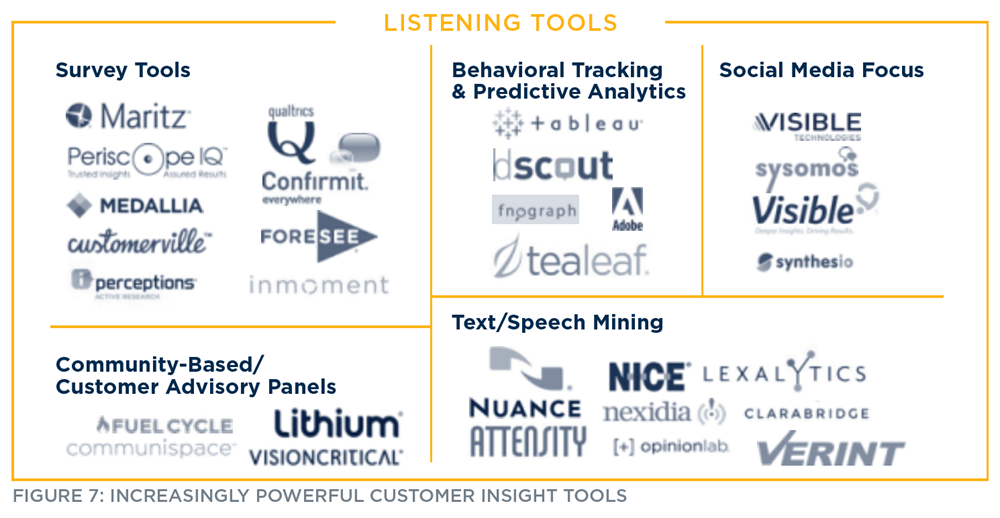Are Efforts to Improve Business Agility Still Immature?
Did you know, only 12% of the Fortune 500 from 1955 were still around in 2016 and more than 50% have disappeared since 2000? We didn’t know that either until we read a new study by West Monroe Partners and the Customer Experience Professionals Association (CXPA) called “Adapt or Fail: The Customer Experience Imperative.” The premise of the research study is to shed light on topics including:
-
What prevents companies from being agile and which area of the organization owns the shift to agile.
-
How CX professionals are well-positioned to lead companies to a new way of thinking.
-
How to increase agility with five common capabilities you may already have.
Since the report was jam-packed with so much data goodness, our media reporter Laura Myers reached out to the author of the report, Paul Hagen, a senior principal in West Monroe’s CX and innovation, to get to the heart of the matter:
It is fascinating how the solution of almost all the internal problems actually boils down to catering to the customer needs. Whether it is reducing churn rate or cutting costs, it is addressing those issues with a customer-serving approach instead of self-serving solutions. That being said, the report unveiled that while 61% of CX execs say their company’s ability to quickly adapt is a top strategic priority, nearly a quarter of the respondents’ orgs have no one dedicated to these efforts. What are those efforts? What does it take to deliver wowing customer experiences? The short answer is increasing business agility.
In the report, Hagen suggests that customer experience design processes borrow heavily from design thinking and Lean methodologies. I couldn’t agree more on this point. As I shared in another CMS-Connected article published in August 2017, design thinking is less about appearances and more about customer experiences. With that in mind, the first phase of the design thinking process is to gain an empathic understanding of the problem by developing knowledge through interactions about what the users do, say, think, and feel.
Hagen touched upon the empathic understanding factor as well, during the video interview. He said: “The foundation of any good customer service program is all about starting to listen and pay attention to customers.” To be able to do that, first and foremost, he suggested that an influential CX professional should have a great sense of empathy for understanding the intentions of customers not to miss the human side of design. It is hard to overestimate the importance of empathy when it comes to leveraging design thinking for a better customer experience as the emphasizing phase helps not only to define the problem but more specifically define it with a human-centered problem statement.
Even if you have the most brilliant empathetic CX professionals within the organizations, it is still so rare to get it right the first time. Therefore, Hagen suggests not only employing CX professionals with the right skill sets but also building a voice of the customer program where brands can gather as much feedback as possible to understand what aspects of the ideas work and what does not to develop almost a prototype. Listening to the voice of the customer doesn’t end there though. Following the prototyping stage, CX professionals keep testing how new ideas/innovations/services resonate with a target audience.
How Technology Speeds Up a Closed-Loop Process
With the advent of technology, it is easier than ever to perform this task. In the report, Hagen shares some powerful tools that help brands quickly understand how customers are feeling and test the success of any initiative. He believes, one of the quickest and most powerful steps to increase business agility is to empower the field and frontline employees with data allows them to respond and adapt behavior based on how customers have perceived previous interactions. From there, he emphasized the importance of establishing a “closed-loop” process by following up with customers.
Here are some listening tools featured in the report:

If you do not have an allocated budget to purchase those tools, in his report, Hagen shares an example from the food industry where a firm utilized GoogleDocs to conduct a rapid “diary study,” and as a result, the company gained so many actionable insights into motivations and experiences of different persona types. These tools are beneficial not only for listening to your existing customer base but also helping to acquire new customers.
Speaking of technology, the report also mentions the importance of having a high-performance architecture, and one of the pieces of advice he gave was adopting microservices. It is a great architecture as it allows marketers and content creators to take their assets wherever they need to be, from websites to microsites, from apps to Internet of Things, in order to quickly turn them into digital experiences across digital channels.
The shift from a traditional, monolithic architecture to cloud-first, based on containers and microservices has simply been driven by today’s uber-connected consumers’ expectations of having a consistent and relevant experience across all digital touchpoints. Now that content can be separated from layout, the repurposing and reuse of content to multiple sites, devices, apps and distribution channels are easier with a microservices architecture. Today, many WCM platforms provide a stateless API that allows users to access and retrieve content and delivery of services through the cloud.
Besides architecture, today, we also have bots acting as a virtual assistant and they are capable of addressing a various range of questions through a various range of modalities to deliver more relevant customer service. However, the fixated misconception and bad experiences about interacting with automated systems had been the coup de grâce for bots adoption for a long time. Now that artificial intelligence continues to evolve, most of the initial issues began to be ironed out. In recognition of the misconception, Agent IQ, an AI-powered customer support platform provider, for instance, took a different approach to AI-powered platform development by bringing back the human touch into the equation, instead of adopting a bot-only approach.
The company also bills itself as the first and only omnichannel solution that combines AI with powerful customer engagement technology to allow agents to interact across channels like web chat, social, email, and voice, resulting in smoother communication and happier customers and employees.
“Bots-only is dead,” said Agent IQ founder and CEO, Craig Davis. “Big-name brands are quickly finding out that customers don’t want to only speak with robots. This is why Agent IQ’s ability to scale intimate one-on-one conversations through AI and save human agents’ expertise for more complicated situations is invaluable to enterprises and their employees.”
CX Is a Mindset Shift
As Hagen said in the video; “CX is more of a mindset shift than an investment.” That’s why, in the report, he outlined three influential methods to help CX professionals translate the data into meaningful action:
-
The closed-loop programs can be taken to the next level by launching follow-ups at a customer journey-level.
-
Establishing a governance model based on customer journeys sheds tremendous light on gaps and opportunities for improvement as it allows CX professionals to provide a view of a firm’s processes and capabilities through the lens of the end-to-end journey a customer takes.
-
Moving from “project-based” work to “outcomes-based” work is another suggestion Hagen made.
He also mentioned about establishing a good North Star reference point that you can always go back to and get your answer whenever you have doubts about the point of any initiative. Here are the elements that your North Star should include:
-
A purpose that transcends products and services to focus on customer outcomes;
-
Inspiration to employees and external partners;
-
Measures of success that customers would use to judge overall performance.
There are so many great tips on how to create greater business agility but overall, placing CX at the helm and putting the customer at the center of a company are important to create great customer experiences, the report suggests.
My POV
When approaching both internal and external business issues, instead of building discussions around technological feasibility and business viability, shifting the mindset to truly and emphatically focusing on customers is essential. While getting that mindset shift ball rolling, it is extremely important to create a collaborative and inclusive environment across and beyond the organizations as people support and embrace changes better when they have a contribution to it. Obviously, this new culture created needs to be supported by instrumental tools. Fortunately, we have more analytics solutions than ever in the market so being proactive with understanding consumer behaviors is not rocket science anymore, and more importantly, it is imperative.

Venus Tamturk
Venus is the Media Reporter for CMS-Connected, with one of her tasks to write thorough articles by creating the most up-to-date and engaging content using B2B digital marketing. She enjoys increasing brand equity and conversion through the strategic use of social media channels and integrated media marketing plans.

Laura Myers
A digital business, marketing and social media enthusiast, Laura thrives on asking unique, insightful questions to ignite conversation. At an event or remotely, she enjoys any opportunity to connect with like-minded people in the industry.